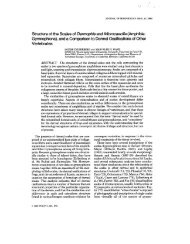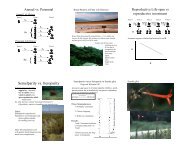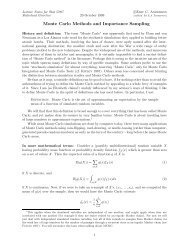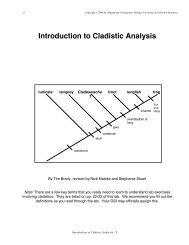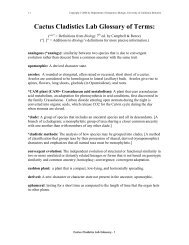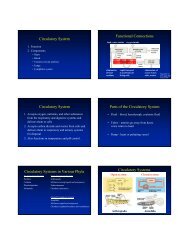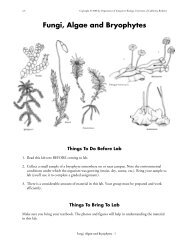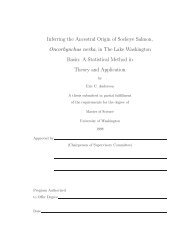Using ecological niche modeling for quantitative biogeographic ...
Using ecological niche modeling for quantitative biogeographic ...
Using ecological niche modeling for quantitative biogeographic ...
You also want an ePaper? Increase the reach of your titles
YUMPU automatically turns print PDFs into web optimized ePapers that Google loves.
590 KAITLIN C. MAGUIRE AND ALYCIA L. STIGALL<br />
man 2006; Stigall 2008). ENM methods were<br />
originally developed <strong>for</strong> modern taxa, and<br />
high levels of predictive accuracy have been<br />
documented (Peterson and Cohoon 1999;<br />
Peterson 2001; Stockwell and Peterson 2002).<br />
In particular, analyzing <strong>niche</strong> conservatism<br />
versus <strong>niche</strong> shifts in <strong>ecological</strong> time (e.g.,<br />
Peterson et al. 2001, 2002; Nunes et al. 2007)<br />
and predicting the extent of species occurrences<br />
<strong>for</strong> conservation purposes (e.g., Peterson<br />
et al. 1999; Raxworthy et al. 2003) have<br />
been highly productive. The only prior use of<br />
ENM methods <strong>for</strong> the fossil record examined<br />
the geographic ranges of Late Devonian<br />
brachiopods in the north Appalachian Basin<br />
across the Frasnian/Famennian (Late Devonian)<br />
boundary (Stigall Rode and Lieberman<br />
2005). Results of that study indicated that the<br />
computer-learning-based algorithms used in<br />
ENM have excellent potential to predict fossil<br />
species ranges from sedimentary parameters.<br />
This study uses the GARP (Genetic Algorithm<br />
using Rule-set Prediction) <strong>modeling</strong> system, a<br />
computer-learning-based analytical ENM<br />
package (Stockwell and Peters 1999). GARP<br />
has been successfully used with numerous<br />
modern mammalian studies investigating<br />
<strong>ecological</strong> and environmental questions (e.g.,<br />
Lim et al. 2002; Illoldi-Rangel and Sánchez-<br />
Cordero 2004) and in studies of marine<br />
invertebrates in the fossil record (Stigall Rode<br />
and Lieberman 2005). This study represents<br />
the first application of ENM and GARP to<br />
fossil vertebrates. The fossil record of equids<br />
is densely sampled and abundant locality<br />
in<strong>for</strong>mation provides a robust record of<br />
where each species lived in North America<br />
(MacFadden 1992). This clade, there<strong>for</strong>e, is an<br />
excellent candidate <strong>for</strong> ENM analysis. Direct<br />
mapping of species ranges from known<br />
occurrence points may underestimate a species’<br />
actual geographic range because of the<br />
inherent biases of the paleontological record<br />
(Kidwell and Flessa 1996; Stigall Rode 2005).<br />
More accurate ranges can be constructed by<br />
using ENM to model species ranges on the<br />
basis of known occurrence points and environmental<br />
parameters estimated from the<br />
sedimentary record (Maguire 2008).<br />
In this study, the distribution patterns of<br />
individual species are examined to better<br />
constrain the rise and fall of the Equinae in<br />
relation to environmental and climatic<br />
change. We model <strong>ecological</strong> <strong>niche</strong>s and<br />
predict geographic ranges in order to study<br />
how species’ distributions shifted through<br />
time as a result of climatic and vegetative<br />
changes. Specifically, we test hypotheses that<br />
habitat fragmentation led to the diversification<br />
of the clade and that distributional<br />
patterns and range size affected the survivorship<br />
of individual species are tested.<br />
Methods<br />
Geographic and Stratigraphic Intervals<br />
Geographic Extent.—The geographic distributions<br />
of equid species were reconstructed<br />
<strong>for</strong> each of two successive time slices during<br />
the middle Miocene through early Pliocene in<br />
the Great Plains region of North America<br />
(Table 1). The study area incorporated regions<br />
of the High Plains, as defined by<br />
Trimble (1980), which comprises northern<br />
Texas, western Oklahoma, western Kansas,<br />
Nebraska, eastern Colorado, southeastern<br />
Wyoming, and southern South Dakota<br />
(Fig. 2). Although equid species also inhabited<br />
regions of North America outside the<br />
study area, we focus our analysis on the<br />
Great Plains region because there is abundant<br />
published data on both the distribution of<br />
equid fossil material and the environmental<br />
setting of the region during the Miocene and<br />
Pliocene. To facilitate analysis of environmental<br />
data, we divided the study region into grid<br />
boxes of 1u longitude by 1u latitude (Fig. 2).<br />
Subdivision of geographic regions at this<br />
scale is standard procedure <strong>for</strong> ENM analyses<br />
of modern organisms (e.g., Stockwell and<br />
Peterson 2002; Wiley et al. 2003; Illoldi-Rangel<br />
and Sánchez-Cordero 2004), and modern<br />
environmental data are typically presented<br />
in this <strong>for</strong>mat. Environmental parameter data<br />
were collected <strong>for</strong> as many 1u grid boxes as<br />
possible from literature sources (Tables 2, 3, 4).<br />
Climatic, Temporal, and Stratigraphic Framework.—Data<br />
were collected <strong>for</strong> two time slices<br />
(Barstovian–Clarendonian and Hemphillian–<br />
Blancan) in order to analyze the distribution<br />
of species through the climatic changes of the<br />
Miocene and Pliocene. Boundaries <strong>for</strong> each



